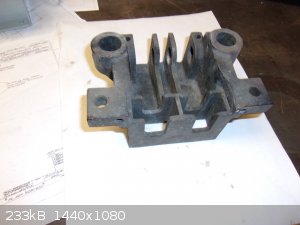Fenwick6
Harmless

Posts: 1
Registered: 22-10-2018
Member Is Offline
|
|
Need advice from some Mad Chemist
Hello Mad Chemist,
I am a machinist with a company that rebuilds large DC mill motors. Last year we had a fire that destroyed our facility. See "Huntingdon Electric
Motor Fire". We were able to salvage some items and have several tons of cast brass brush-holders that we would like to reuse as some of them are no
longer available. Problem is they are coated with a well adhered blackening that I assume is baked on smoke residue. It seems it can only be removed
with labor intensive bead blasting. I am looking to find a chemical dip method to restore them to bright finish. I have tried ZEP 7961 phosphoric acid
cleaner but it only etches the non blackened areas and does nothing to the bulk of the residue. I believe this is due to the caustic nature of the
residue forming a sort of inhibiting barrier. I have thought about heating the acid bath but I don't fave a fume hood in place and am not sure if this
would have an effect. Does anyone have any ideas about other dip chemicals which may dissolve the blackening without heavy removal of the base
material? I can acquire a fume hood and PPE if necessary.
Thanks in advance for you consideration and responses,
Fenwick6

|
|
|
zed
International Hazard
    
Posts: 2283
Registered: 6-9-2008
Location: Great State of Jefferson, City of Portland
Member Is Offline
Mood: Semi-repentant Sith Lord
|
|
Try Acetone, or Methylene Dichloride. These solvents will dissolve most types of organic crud, while hopefully leaving the metal alone.
Such formulations usta be used in "Paint Strippers". I've seen guys spray whole house exteriors with stripper, let it sit for a while, until all off
the paint blistered, and then follow up with pressure washing.
In SF, we used a local product labeled "Green's". Until a few years ago, "Jasco" offered a similar formulation.
Bare wood!
If however, the surface of the metal was oxided by excessive heat. Maybe electrolysis, and/or electroplating is the answer.
Or perhaps, a product like "Tarn-X"
[Edited on 11-3-2021 by zed]
[Edited on 11-3-2021 by zed]
|
|
|
Texium
Administrator
       
Posts: 4580
Registered: 11-1-2014
Location: Salt Lake City
Member Is Offline
Mood: PhD candidate!
|
|
My first recommendation would be tetrachloroethylene. It does as well or better than DCM, but is less volatile and less toxic. It is sold as brake
parts cleaner, so you can buy a spray can of it at any automotive store if you just want to test it out, but it should also be readily available from
industrial chemical suppliers if it works and you need a larger amount. It's the most common solvent used in dry cleaning as well.
This is the stuff you'll want: https://www.amazon.com/Brake-Maintenance-Tools-Set/dp/B08TMS...
You can tell that it's tetrachloroethylene since they adverstise it as non-flammable. The non-halogenated stuff is not the same and will not work as
well.
If that doesn't work, another good option that would be very cheap would be a nice caustic soak in a concentrated sodium hydroxide bath. Only issue
there is you might end up with some pitting on the parts since they are brass, but the organic crud would likely react and slough off much faster,
before the parts are damaged significantly. Sodium hydroxide is used in heavy duty oven cleaners though, so that's a testament to how good it is at
liquifying burnt on crud.
|
|
|
macckone
Dispenser of practical lab wisdom
    
Posts: 2168
Registered: 1-3-2013
Location: Over a mile high
Member Is Offline
Mood: Electrical
|
|
I second automotive brake or electrical parts cleaner both are basically the same.
The brake cleaner may contain other hydrocarbons but the electrical parts cleaner is usually straight TCE.
If the coating is straight carbon, not much will dissolve it without damaging the metal.
Elbow grease is sometimes the best way to remove stuff like this.
|
|
|
Texium
Administrator
       
Posts: 4580
Registered: 11-1-2014
Location: Salt Lake City
Member Is Offline
Mood: PhD candidate!
|
|
The brake cleaner that I linked to is straight TCE with no hydrocarbons.
|
|
|
violet sin
International Hazard
    
Posts: 1480
Registered: 2-9-2012
Location: Daydreaming of uraninite...
Member Is Offline
Mood: Good
|
|
Ive found brake fluid itself useful for stripping baked on enamel from a scroll saw casing, especially if its got some scratches through the surface
and isnt just attacking a perfect membrane. i wouldnt want to have to dispose of multiple tainted gallons of it though, sounds like a headache. best
of luck.
|
|
|
Swinfi2
Hazard to Others
  
Posts: 131
Registered: 19-2-2018
Location: England
Member Is Offline
Mood: Catalytic
|
|
I can't see the bronze burning but carbon definitely should. Could you burn it off? That said a lot of heat will soak into the metal before its hot
enough to burn the carbon so might be impractical at scale.
|
|
|
Amos
International Hazard
    
Posts: 1406
Registered: 25-3-2014
Location: Yes
Member Is Offline
Mood: No
|
|
TCE is trichloroethylene, while tetrachloroethylene is usually referred to as PCE or PERC (perchloroethylene)
|
|
|
pneumatician
Hazard to Others
  
Posts: 412
Registered: 27-5-2013
Location: Magonia
Member Is Offline
Mood: ■■■■■■■■■■ INRI ■■■■■■■■■■ ** Igne Natura Renovatur Integra **
|
|
goto a marine shop, or ask some fisherman, or in a snob club of "sailors"... these guys have a lot of brass in their boats and known very well how to
clean and polish it.
|
|
|